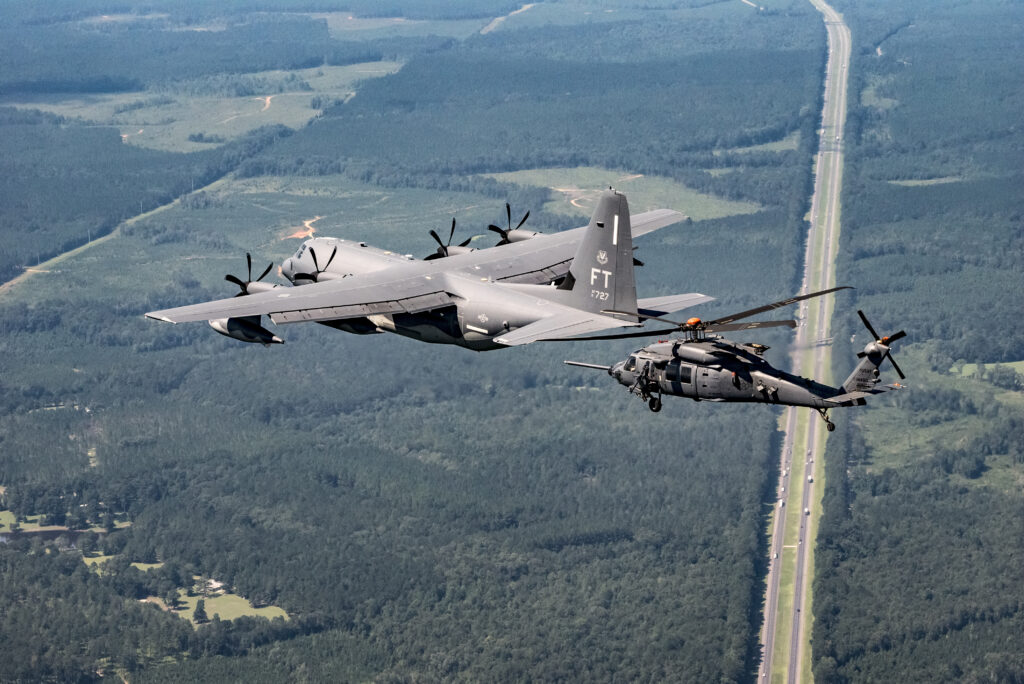
An HH-60W Jolly Green II connects with a HC-130J tanker. The final FY24 defense bill adds 10 HH-60Ws and eight C-130Js. – U.S. Air Force
Aircraft and combat vehicles were among the big winners of the final FY24 defense appropriations bill, while spending on missiles and space programs saw a decline compared to the administrator’s request, according to Forecast International’s FY24 U.S. Defense Budget Spotlight.
The FY24 conference appropriations bill was passed by Congress and signed into law late last month, nearly six months after the start of the 2024 fiscal year. Up to that point, the military had been operating at FY23 spending levels under a series of continuing resolutions. With a final budget in place, the Pentagon is able to move forward with launching new start programs and implementing planned production increases for various programs that were not possible under the CRs.
The final defense bill provides $825 billion for the Pentagon in FY24, excluding military construction that is funded in a separate spending bill, reflecting a cut of $1.7 billion compared to the request. If you include military construction, the Pentagon is funded at $843.6 billion in FY25, roughly in line with the administrator’s request (MILCON saw a $2 billion plus-up). The final topline had already been set by the Fiscal Responsibility Act of 2023, which established defense spending limits in FY24 and FY25.
Acquisition funding fared well as a whole in the final budget, with lawmakers adding around $3.1 billion (+1.8%) for procurement of new equipment and $3.3 billion (+2.3%) for research, development, test & evaluation. Both categories received more funding than in any of the previous House or Senate proposals from earlier in the FY24 budget process. House appropriators had originally recommended cutting $3.9 billion for procurement, while Senate appropriators originally wanted a $1.3 billion increase.
The Navy saw a massive injection of $2.5 billion for aircraft, reflecting growth of more than 14 percent above the request. The extra funding helped buy additional 10 P-8A maritime patrol aircraft, five V-22s, two E-2Ds, and a KC-130J. The Air Force also received funding for an extra three F-35As, eight C-130Js, and 10 HH-60W combat search-and-rescue helicopters. Several UH-60 and CH-47 helicopters were also added for the Army.
The FY24 spending bill provided a nearly $500 million increase for Army’s weapons and combat vehicles, which is almost 13 percent above the request. Abrams, Bradley, Stryker, and Paladin combat vehicles all received additional funding in the bill, but money was cut from the Armored Multi-Purpose Vehicle and Joint Light Tactical Vehicle programs.
The Air Force and Navy weapons accounts were also reduced by 15.1 percent and 14.5 percent, respectively. The cuts were largely attributed to the Air Force’s Sentinel ballistic missile and the Navy’s hypersonic Conventional Prompt Strike weapon. Lawmakers transferred some of the procurement funding to support continued development of the weapons.
Space Force procurement fell by $649 million, or nearly 14 percent, in the final budget. Most of the reduction was for classified space activities, for which funding dropped by 55 percent.
All the services gained funding for research and development programs in FY24. The Army and Navy research budgets increased by $1.3 billion (+8.5%) and $1 billion (+3.9%), respectively. The Department of the Air Force received a net $245.6 million increase, which is the result of an additional $775.1 million for the Air Force and a cut of $529.5 million for the Space Force.
Since the Pentagon’s topline budget was frozen at the FY24 request level, the acquisition plus-ups were offset by reductions in the personnel and operation & maintenance accounts, each of which saw reductions of more than $2.5 billion.
Sign up for Forecast International’s free FY24 U.S. Defense Budget Spotlight to see more information about the FY24 budget process. Even more details, including line-by-line tracking of the Pentagon’s entire acquisition budget, are available in Forecast International’s U.S. Defense Budget Forecast database.
More Defense Budget Data
Forecast International’s U.S. Defense Budget Forecast makes it easy to navigate the latest U.S. defense budget. The product features sorting and data visualization options and presents the entire Future Years Defense Program (FYDP) through an online interface with downloadable spreadsheets. This is the go-to service for anyone looking to save time and energy in navigating the massive Department of Defense budget.
As editor of International Military Markets, North America, Shaun has cultivated a deep understanding of the vast defense markets in the United States and Canada. Shaun's perspective on defense procurement and budget issues has been cited in a variety of defense periodicals, including Defense News and National Defense Magazine. Further, Shaun played an integral role in the development of Forecast International's U.S. Defense Budget Forecast product, which offers an unprecedented level of insight into the Pentagon's acquisition budget. In addition to providing original analytical content for the U.S. Defense Budget Forecast, Shaun oversees an internal defense budget forecasting process involving Forecast International's team of skilled systems analysts following release of the DoD's annual budget request. Shaun is also in charge of managing Forecast International's Weapons Inventory database.




